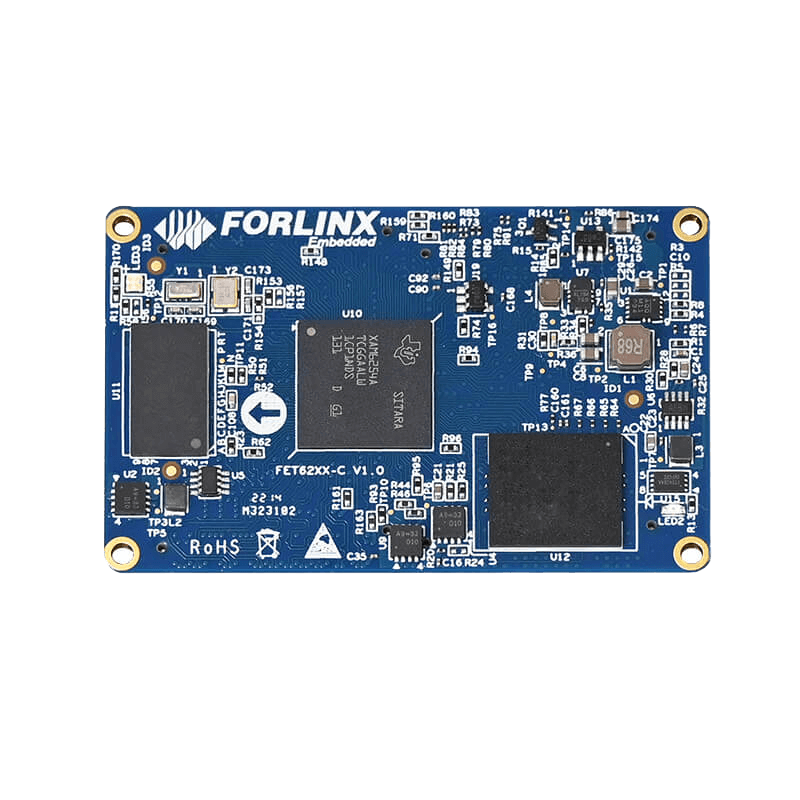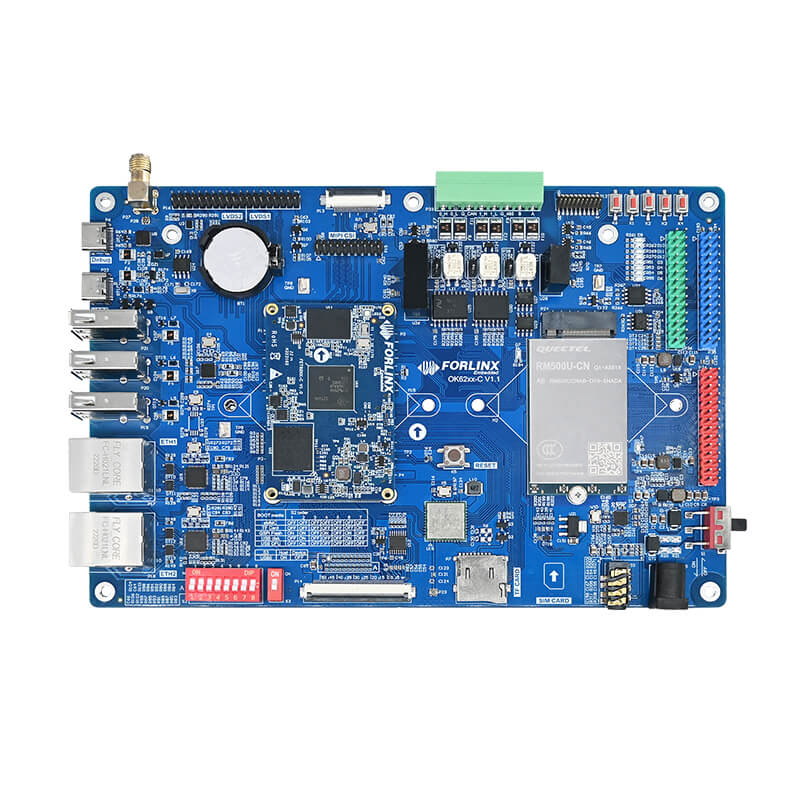
Efficient Deployment of Forlinx OK62xx-C Development Board Firmware on Linux via NFS and TFTP
Overview
This article introduces how to update the image over the network using NFS and TFTP on the OK62xx-C series development boards. Please refer to the document for the operations.
Application Scope
This article is mainly applicable to the Linux 6.1.33 operating system on the Forlinx OK62xx-C platform. Other platforms can also refer to it, but there will be differences between different platforms. Please make modifications according to the actual conditions.
1. Updating the Image over the Network using NFS and TFTP
NFS (Network File System) is a distributed file-sharing protocol that allows a computer to transparently access a remote file system over the network. It is commonly used to mount the root file system in embedded development.
1.1 NFS Service Setup
1). The method to set up an NFS server on Ubuntu is as follows:
Software Download and Installation
forlinx@ubuntu:~# sudo apt-get install nfs-kernel-server nfs-common portmap
Create an NFS Directory and Extract the File System (Take the rootfs.tar.bz2 file system as an example, and the current directory is the root directory)
forlinx@ubuntu:~# cd / forlinx@ubuntu:/# sudo mkdir nfs_rootfs forlinx@ubuntu:/# sudo tar -xvf rootfs.tar.bz2 -C /nfs_rootfs/
Modify the configuration file
forlinx@ubuntu:/# sudo vim /etc/exports
Add the following configuration to the file:
/nfs_rootfs *(rw,sync,no_root_squash,no_subtree_check)
Restart profiles and services
forlinx@ubuntu:/# sudo exportfs -rv forlinx@ubuntu:/# sudo /etc/init.d/rpcbind restart forlinx@ubuntu:/# sudo /etc/init.d/nfs-kernel-server restart
2) Verify the NFS server on the development board. After executing the following command, mount the NFS server to the /mnt directory of the development board:
root@imx6ulevk:~# mount -t nfs4 -o vers=4 192.168.0.57:/nfs_rootfs /mnt
After the successful mounting, check the /mnt directory, and you will see the file system that was just extracted.
root@imx6ulevk:~# ls /mnt/
Note: 192.168.0.57 is the IP address of the Ubuntu host of the NFS server. The network of Ubuntu needs to be set to the bridged mode and be in the same network segment as the development board. Copy the contents of /OK62xx - linux - fs/rootfs in the source code to /nfs_rootfs.
As shown in the figure:
Test NFS in the U-Boot stage of the development board.
Set the environment variables:
=> setenv ipaddr 172.16.0.141 //Development board ip => setenv serverip 172.16.0.142 //Server ip => nfs /home/forlinx/nfs_rootfs/bin/tar.tar //Download the file via NFS (absolute path here) link up on port 1, speed 1000, full duplex Using ethernet@8000000 device File transfer via NFS from server 172.16.0.141; our IP address is 172.16.0.142 Filename '/nfs_rootfs/bin/tar.tar'. Load address: 0x82000000 Loading: ################################################################# ############################## done Bytes transferred = 482272 (75be0 hex)
1.2 TFTP Service Setup
TFTP (Trivial File Transfer Protocol) is a lightweight UDP - based file transfer protocol, mainly used for booting diskless devices or quickly transferring small files such as kernel images in embedded systems.
1)Install the server, client, and daemon process.
forlinx@ubuntu:~$ sudo apt-get install tftp-hpa tftpd-hpa xinetd
2)Server configuration
First, create a tftpboot directory in the root directory and change its attributes to allow any user to read and write:
forlinx@ubuntu:~$ cd / forlinx@ubuntu:~ sudo mkdir nfs_rootfs forlinx@ubuntu:~$ sudo chmod 777 tftpboot
Then, enter the directory/etc/xinetd. d/, create a new file TFTP in it, and add the specified content to the TFTP file:
forlinx@ubuntu:~$ cd /etc/xinetd.d/ forlinx@ubuntu:~$ sudo vim tftp
Add the following to the TFTP file:
service tftp
{
disable = no 138
socket_type = dgram
protocol = udp
wait = yes
user = root
server = /usr/sbin/in.tftpd
server_args = -s /tftpboot -c
per_source = 11
cps = 100 2
}
Finally, modify the configuration file/etc/default/tftpd-hpa
forlinx@ubuntu:~$ sudo vim /etc/default/tftpd-hpa
Modify to
TFTP_USERNAME="tftp" TFTP_DIRECTORY="/tftpboot" TFTP_ADDRESS="0.0.0.0:69" TFTP_OPTIONS="--secure -l -c -s"
Note change the TFTP _ DIRECTORY "to the path where the new tftpboot directory is created.
3)Restart the service
forlinx@ubuntu:~$ sudo /etc/init.d/xinetd reload forlinx@ubuntu:~$ sudo /etc/init.d/xinetd restart forlinx@ubuntu:~$ sudo /etc/init.d/tftpd-hpa restart
4)Test the server
To test it, create a new file in the/tftpboot folder
forlinx@ubuntu:/tftpboot$ sudo touch abc
Go to another folder
forlinx@ubuntu:/tftpboot$ cd /home/ forlinx@ubuntu:/home$ sudo tftp 192.168.2.51 //192.168.2.51 is the local IP tftp> get abc tftp> quit forlinx@ubuntu:/home$ ls abc
If the download is successful, it indicates that the server has been installed correctly. After connecting the development board to the PC via an Ethernet cable, the TFTP can be used to download files. Then, put the AM6254 image Image and OK6254 - C.dtb into the tftpboot folder.
Test TFTP in the U - Boot stage of the development board.
Set the environment variables:
=> setenv ipaddr 172.16.0.141 //Development board ip => setenv serverip 172.16.0.142 //Server ip => tftpboot Image //Download files via TFTP link up on port 1, speed 1000, full duplex Using ethernet@8000000 device TFTP from server 172.16.0.141; our IP address is 172.16.0.142 Filename 'Image'. Load address: 0x82000000 Loading: ################################################################# ################################################################# ################################################################# ################################################################# ################################################################# ################################################################# ################################################################# ################################################################# ################################################################# ################################################################# ################################################################# ################################################################# ################################################################# ################################################################# ################################################################# ################################################################# #################################################################T ################################################################# ################################################################# ################################################################# ################################################################# ############ 1.7 MiB/s done Bytes transferred = 20206080 (1345200 hex)
2. Network Boot File System
=> setenv ipaddr 172.16.0.142 //Development board ip
=> setenv serverip 172.16.0.141 //Server ipsetenv
=> setenv image Image
=> setenv fdt_file OK6254-C.dtb
=> setenv netargs "setenv bootargs console=ttyS2,115200 root=/dev/nfs rw ip=172.16.0.142:172.16.0.141:172.16.0.1:255.255.255.0::eth0:off nfsroot=172.16.0.141:/nfs_rootfs,v3,tcp"
=> setenv netboot "run netargs; tftpboot ${loadaddr} ${image}; tftpboot ${fdtaddr} ${fdt_file}; booti ${loadaddr} - ${fdtaddr}"
=> saveenv
Saving Environment to MMC... Writing to MMC(0)... OK
=> run netboot
3. Kernel Image, Device Tree, and U-Boot Image Update
After the network boot is completed, copy the files in the network file system to mmcblk0p1 and mmcblk0p2 using the following commands:
cp /boot/Image /run/media/mmcblk0p2/boot/ //Update the kernel image cp /boot/OK6254-C.dtb /run/media/mmcblk0p2/boot/ //Update the device tree cp /boot/u-boot.img /run/media/mmcblk0p1/ //Update the U-Boot image sync
Note: After the network boot, the file system of the development board is the same as the one placed in the virtual machine. The original file system in the eMMC of the development board is located at /run/media/mmcblk0p2/. Therefore, you only need to copy the images in the network file system to the corresponding positions of the images in the eMMC file system to update the images.



